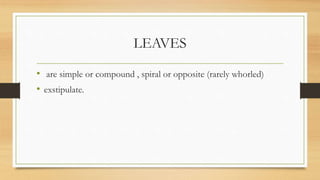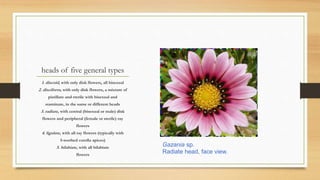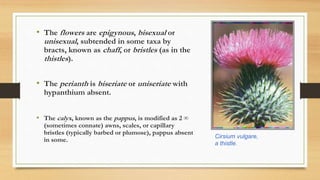- The Asteraceae family includes herbs, shrubs, trees, or vines distinguished by heads (capitula) of flowers subtended by involucres of phyllaries.
- The heads contain disk flowers, ray/ligulate flowers, or a mixture of the two. The calyx is modified as scales, awns, or bristles called a pappus.
- The flowers have 5 (rarely 4) stamens fused into a tube, a single style with two branches, and a single basal ovule in the inferior ovary. The fruit is a multiple of achenes.










![The corolla is sympetalous with 5 [rarely 4] lobes
(reduced to 3 marginal teeth in some), of three
structural types (also called flower types):
(1) bilabiate, corolla zygomorphic with a short tube
having upper and lower lips
(2) disk, corolla actinomorphic with short
to elongate tube bearing 5 [4] teethlike
or elongate lobes; or
(3) ray or ligulate, corolla zygomorphic
with generally short tube having elongate,
flat, extension bearing 3 5 apical teeth.](https://image.slidesharecdn.com/asteraceae-180613215833/85/Asteraceae-11-320.jpg)
![• The stamens are 5
[4], whorled, alternipetalous,
usually syngenesious, the
anthers fused into a tube
through which the style
grows.
• Anthers are basifixed, with
apical extensions and
sometimes basal lobes,
longitudinal and introrse in
dehiscence.
Female heads
Ambrosia [Hymenoclea]
salsola
Discoid heads; male heads](https://image.slidesharecdn.com/asteraceae-180613215833/85/Asteraceae-12-320.jpg)



![SUMMARY
• The Asteraceae are distinctive in being herbs,
• shrubs, vines,
• or trees, the inflorescence a head (capitulum) subtended
• by
• an involucre of phyllaries, flowers either bilabiate, disk, or
• ray/ligulate (heads of many taxa a mixture of central disk
• flowers and peripheral ray flowers), with the calyx,
• termed
• a pappus, modified as scales, awns, or capillary bristles
• (or absent), the androecium syngenesious, and with an
• inferior ovary with a single, basal ovule, the fruit a
• multiple of achenes.
K 0-∞ (pappus) C (5) [(4)] or (3) in
some ray flowers A (5) [(4)] G
(2), inferior.](https://image.slidesharecdn.com/asteraceae-180613215833/85/Asteraceae-16-320.jpg)
